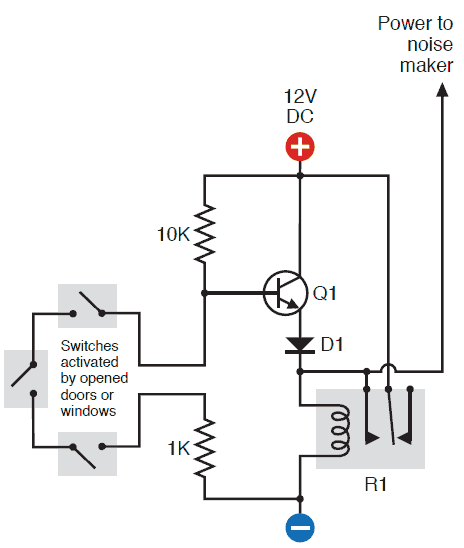
motorcycle alarm series

This circuit is designed to create an early warning alarm system for any form of theft that is important to the owners of a motorcycle or bicycle. This alarm system can utilize a number of normally open switches, such as a mercury switch. It operates by allowing or disrupting the flow of electric current in a circuit. The physical position or alignment of the switch in relation to the gravity of the Earth affects many functions depending on the switch's orientation. No current will flow to the electrical contacts as long as the mercury remains at the lowest point of the glass bulb. However, when the switch is tilted at an angle or in a certain direction, the liquid mercury will touch the set of contacts, generating an electrical connection between them. When the switch is tilted back in the opposite direction, the flow of electric current will stop immediately. The following is a schematic drawing: the mercury switch is positioned to close when the bike is lifted off its side stand, pushed forward from its center stand, or otherwise moved. A siren will sound for at least one minute after being triggered. The alarm will reset after about two minutes when the switch has been opened again. Changing the value of capacitor C1 alters the time delay for the alarm to turn off. When the alarm is silent, it consumes almost no current.
This early warning alarm system is particularly effective for protecting motorcycles and bicycles from theft. The use of a mercury switch is advantageous due to its sensitivity to orientation changes. The mercury switch, typically enclosed in a glass bulb, contains a small amount of liquid mercury that completes the circuit when tilted. The design ensures that the alarm activates only when the vehicle is disturbed, thereby minimizing false alarms caused by environmental factors.
The circuit can be represented schematically with the mercury switch connected in series with a siren and a capacitor. The siren acts as the alarm output, while the capacitor (C1) plays a crucial role in timing the deactivation of the alarm. When the circuit is closed by the mercury switch, current flows through the siren, producing an audible alert. The duration of the alarm can be adjusted by altering the capacitance of C1; a larger capacitance will result in a longer delay before the alarm turns off.
The circuit is powered by a suitable battery, which ensures portability and ease of installation on motorcycles and bicycles. Additionally, the low power consumption when the alarm is inactive allows for prolonged battery life, making the system efficient and user-friendly. The overall design emphasizes simplicity and reliability, providing an essential layer of security for valuable two-wheeled vehicles.This circuit is designed to create an early warning alarm system for any form of theft that are important to the owners of a motorcycle or bicycle. This alarm system can be used a number of normally open switches such as mercury (italics) switch. It works by allowing or disrupt the flow of electric current in a circuit. Physical position or alignm ent of the switch in relation to the gravity of the earth is a place where many functions depending on buttons. No current will flow to the electrical contacts along the mercury remained at the lowest point of the glass bulb.
However, after the switch is tilted at an angle or a certain direction, the liquid mercury will touch the set of contacts and will generate electrical connections between the contacts. When the switch is tilted back in the opposite direction of electric current to stop immediately. The following is a schematic drawing: Mercury switch is positioned so that they will close when the bike is lifted off his side stood, pushed forward from its center stand, or the director will be moved.
Sirens will sound for at least one wizard that will be closed. The alarm will reset, after about two minutes, when the switch has been opened again. Change the value of capacitor C1 changes the time delay for the alarm to turn OFF. When the alarm is silent, almost no current use. 🔗 External reference
This early warning alarm system is particularly effective for protecting motorcycles and bicycles from theft. The use of a mercury switch is advantageous due to its sensitivity to orientation changes. The mercury switch, typically enclosed in a glass bulb, contains a small amount of liquid mercury that completes the circuit when tilted. The design ensures that the alarm activates only when the vehicle is disturbed, thereby minimizing false alarms caused by environmental factors.
The circuit can be represented schematically with the mercury switch connected in series with a siren and a capacitor. The siren acts as the alarm output, while the capacitor (C1) plays a crucial role in timing the deactivation of the alarm. When the circuit is closed by the mercury switch, current flows through the siren, producing an audible alert. The duration of the alarm can be adjusted by altering the capacitance of C1; a larger capacitance will result in a longer delay before the alarm turns off.
The circuit is powered by a suitable battery, which ensures portability and ease of installation on motorcycles and bicycles. Additionally, the low power consumption when the alarm is inactive allows for prolonged battery life, making the system efficient and user-friendly. The overall design emphasizes simplicity and reliability, providing an essential layer of security for valuable two-wheeled vehicles.This circuit is designed to create an early warning alarm system for any form of theft that are important to the owners of a motorcycle or bicycle. This alarm system can be used a number of normally open switches such as mercury (italics) switch. It works by allowing or disrupt the flow of electric current in a circuit. Physical position or alignm ent of the switch in relation to the gravity of the earth is a place where many functions depending on buttons. No current will flow to the electrical contacts along the mercury remained at the lowest point of the glass bulb.
However, after the switch is tilted at an angle or a certain direction, the liquid mercury will touch the set of contacts and will generate electrical connections between the contacts. When the switch is tilted back in the opposite direction of electric current to stop immediately. The following is a schematic drawing: Mercury switch is positioned so that they will close when the bike is lifted off his side stood, pushed forward from its center stand, or the director will be moved.
Sirens will sound for at least one wizard that will be closed. The alarm will reset, after about two minutes, when the switch has been opened again. Change the value of capacitor C1 changes the time delay for the alarm to turn OFF. When the alarm is silent, almost no current use. 🔗 External reference
Warning: include(partials/cookie-banner.php): Failed to open stream: Permission denied in /var/www/html/nextgr/view-circuit.php on line 713
Warning: include(): Failed opening 'partials/cookie-banner.php' for inclusion (include_path='.:/usr/share/php') in /var/www/html/nextgr/view-circuit.php on line 713





